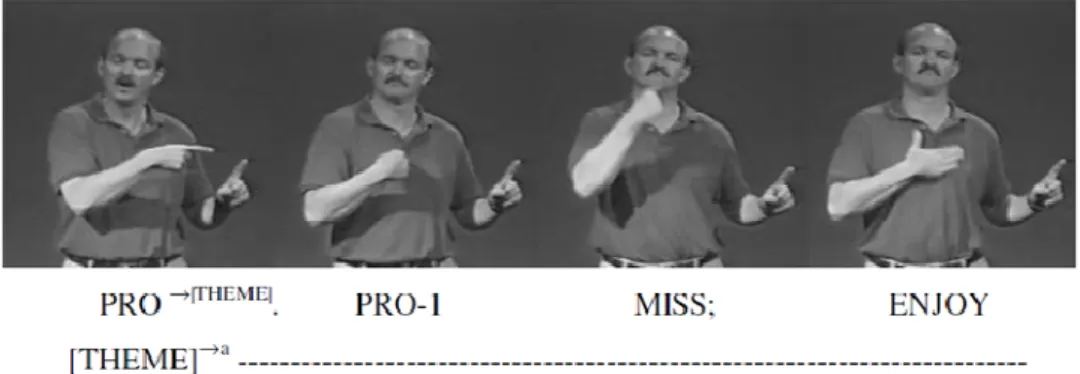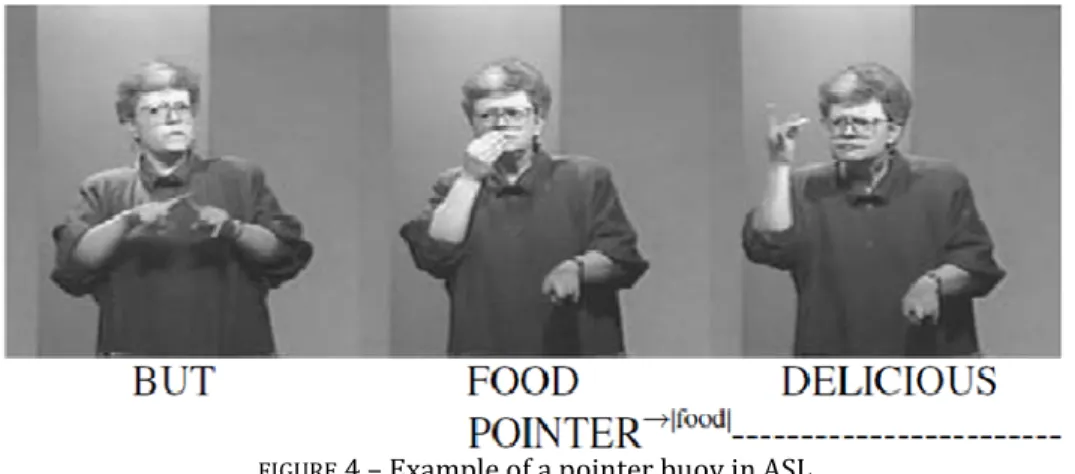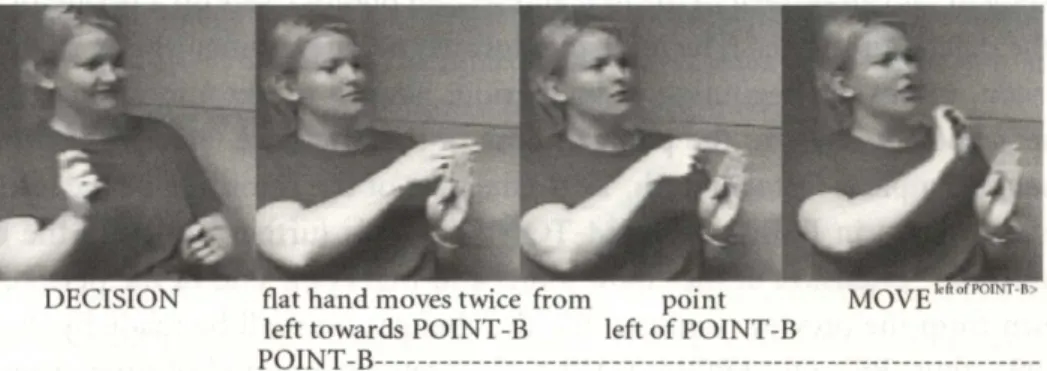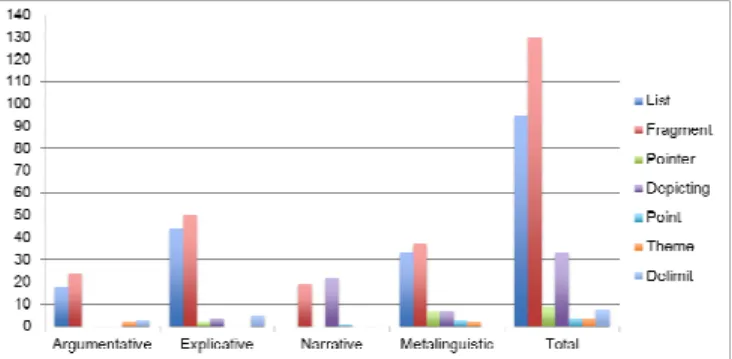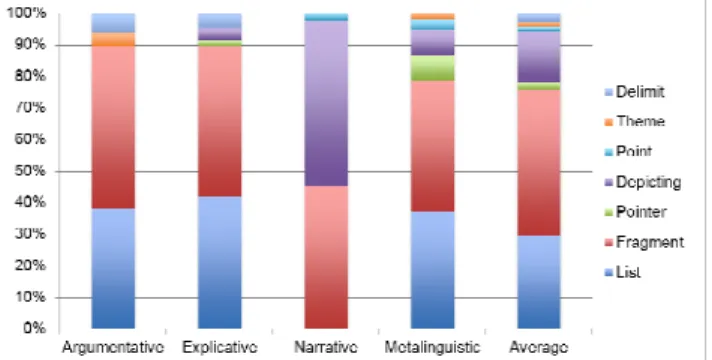RESEARCH OUTPUTS / RÉSULTATS DE RECHERCHE
Author(s) - Auteur(s) :
Publication date - Date de publication :
Permanent link - Permalien :
Rights / License - Licence de droit d’auteur :
Bibliothèque Universitaire Moretus Plantin
Institutional Repository - Research Portal
Dépôt Institutionnel - Portail de la Recherche
researchportal.unamur.be
University of Namur
The Use of Buoys across Genres in French Belgian Sign Language (LSFB)
Gabarro-Lopez, Silvia; Meurant, Laurence
Published in:
Actes du IXème colloque de linguistique des doctorands et jeunes chercheurs du Laboratoire MoDyCo (COLDOC 2013)
Publication date:
2014
Document Version
Peer reviewed version
Link to publication
Citation for pulished version (HARVARD):
Gabarro-Lopez, S & Meurant, L 2014, The Use of Buoys across Genres in French Belgian Sign Language (LSFB). in Actes du IXème colloque de linguistique des doctorands et jeunes chercheurs du Laboratoire
MoDyCo (COLDOC 2013): La question des genres à l'écrit et à l'oral. pp. 43-54, COLDOC2013. La question des
genres à l'écrit et à l'oral, Paris, France, 13/11/13.
General rights
Copyright and moral rights for the publications made accessible in the public portal are retained by the authors and/or other copyright owners and it is a condition of accessing publications that users recognise and abide by the legal requirements associated with these rights. • Users may download and print one copy of any publication from the public portal for the purpose of private study or research. • You may not further distribute the material or use it for any profit-making activity or commercial gain
• You may freely distribute the URL identifying the publication in the public portal ?
Take down policy
If you believe that this document breaches copyright please contact us providing details, and we will remove access to the work immediately and investigate your claim.
THE USE OF BUOYS ACROSS GENRES IN FRENCH BELGIAN SIGN
THE USE OF BUOYS ACROSS GENRES IN FRENCH BELGIAN SIGN
THE USE OF BUOYS ACROSS GENRES IN FRENCH BELGIAN SIGN
THE USE OF BUOYS ACROSS GENRES IN FRENCH BELGIAN SIGN
LANGUAGE (LSFB)
LANGUAGE (LSFB)
LANGUAGE (LSFB)
LANGUAGE (LSFB)
Sílvia Gabarró-López
1,2Laurence Meurant
1,2 (1) FRS – FNRS, 5, rue d’Egmont 1000 Bruxelles (2) University of Namur, 61, rue de Bruxelles 5000 Namursilvia.gabarro@unamur.be, laurence.meurant@unamur.be
ABSTRACT
Malrieu (2004) approaches genres from a global characterization of them followed by a morphosyntactic and semantic disambiguation of smaller units than the text but bigger units than the sentence. Our study consists in taking the so-called “buoys” as a morphosyntactic element, and exploring whether they can be used as devices to distinguish between genres in French Belgian Sign Language (LSFB). Buoys are signs produced with the weak hand maintained while the other goes on signing (Liddell, 2003). We have gathered a balanced corpus of one signer including argumentative, explicative, narrative and metalinguistic productions, which has been annotated and analysed. We look at (i) the distribution of buoys across genres and their frequency of appearance; and (ii) the scope of discourse which is covered by a particular buoy and the role of the buoy in discourse cohesion.
RESUME
L’usage des balises à travers des genres en langue des signes de Belgique francophone (LSFB) L’usage des balises à travers des genres en langue des signes de Belgique francophone (LSFB)L’usage des balises à travers des genres en langue des signes de Belgique francophone (LSFB) L’usage des balises à travers des genres en langue des signes de Belgique francophone (LSFB) Malrieu (2004) présente une démarche de description différentielle des genres fondée sur la désambiguïsation morphosyntaxique et sémantique d’unités inférieures au texte mais supérieures à la phrase. Nous appliquons cette démarche aux dénommées « balises », afin de savoir s’il s’agit d’éléments pertinents pour la distinction des genres en langue des signes de Belgique francophone (LSFB). Les balises résultant du maintien de la main non dominante pendant que l’autre continue à signer (Liddell, 2003). Un corpus de productions argumentatives, explicatives, narratives et métalinguistiques d’un même signeur a été rassemblé et annoté pour mener cette analyse. Nous y étudions (i) la distribution des balises et la fréquence d’apparition des balises à travers les genres et (ii) l’amplitude des portions de discours sur lesquels portent les différentes balises et le rôle de la balise pour la cohésion discursive.
KEYWORDS: French Belgian Sign Language, Genre, Buoys, Corpus linguistics, Organization of the discourse, Anaphora.
MOTS-CLES : Langue des signes de Belgique francophone, Genre, Balises, Linguistique de corpus, Organisation du discours, Anaphore.
Introduction
Introduction
Introduction
Introduction
The study of sign language (SL) linguistics is a very young discipline which started in the 60s, so most SLs are understudied. SL productions are quite different from spoken language (SpL) productions: for instance, we may not find pleas originally produced in a SL at present, but we will have lots of discussions going on between deaf signers on the sign for a particular concept. Furthermore, SLs do not count on a written tradition but only on an oral one. Deaf
children from deaf families have learnt the language from their parents, whereas deaf children from hearing families have learnt it at a boarding school for the deaf, from peers, on the playground.
French Belgian SL (LSFB) is the language used by the members of the Deaf Community in Wallonia and Brussels. Its situation is that of a minority and a minorized language: the number of signers is quite limited (according to Meurant (2006), 4000 people approximately) and the presence of the language in society is rare. Furthermore, deaf people have had (and some still have) a negative view of LSFB because French was imposed as the language to be used and LSFB was disregarded. Therefore, we are talking about a language and a linguistic community with a particular status. Moreover, research on LSFB began in 2000, so few bibliographical resources exist so far, and the study of genres has rarely been tackled in what little literature there is.
This paper aims at casting light on the characterization of genres in LSFB. The first section will explain how genres have been studied in SLs, which SpL approaches may be used for the purposes of our study and what buoys are. The second and third sections deal with how we approach buoys in relation to genres, starting with a description of how our corpus has been built, how the annotation was done and how the analyses were performed. The fourth section will give an account of the results, and the fifth section will conclude and make suggestions on the elements that would complete buoys for the description of discourse markers in LSFB and their use across genres.
The study of genres in SLs
The study of genres in SLs
The study of genres in SLs
The study of genres in SLs
Literature on SL genres is scarce and mainly covers conversation (essentially the organisation of turn-taking (Baker, 1977)) and narration (perspective choice and variation, the use of space for discourse cohesion (Perniss, 2007 and Winston, 1999)). Very few works deal with other genres (Sallandre, 2003), or go through discourse markers (Mertzger et al., 2001 and Johnston et al., 2007), self-corrections (Mertzger et al., 2001) and registers (Zimmer, 1989). To date, no work deals with the characterisation and classification of genres in SLs.
If we want to do so, we need to take studies of SpL genres as a starting point, particularly those of oral genres, even if oral productions have rarely been approached (Kerbrat-Orecchioni et al., 2004). Although genre theories are diverse and complex, the way Malrieu (2004) approaches the problem is very interesting and may fit well in this incipient domain. She starts from a global characterisation of genres and then carries out a morphosyntactic and semantic disambiguation; that is to say, she explores how genres are constrained by smaller units than the text but bigger units than the sentence. For this purpose, we have chosen a morphosyntactic element which is only found in SLs, the so-called “buoys”, and we would like to see if they could serve to distinguish between genres in LSFB.
2.1
2.1
2.1
2.1
Buoys
Buoys
Buoys
Buoys
Liddell (2003) was the first to name and describe these “signs produced with the weak hand that are held in a stationary configuration as the strong hand continues producing signs. Semantically they help guide the discourse by serving as conceptual landmarks as the
discourse continues” (Liddell, 2003:239). He distinguishes five types of buoys in American SL (ASL): the list, the theme, the fragment, the pointer and the depicting buoy. List buoys are numeral signs that are held and used to make associations with from one to five ordered or unordered entities. The index finger of the strong hand contacts one finger of the weak hand before or after the description of an entity, and the weak hand may remain or drop during the discourse.
FIGURE 1 – Example of a five-list buoy in ASL
Second, theme buoys are formed with a raised and stationary vertical index finger on the weak hand meaning that an important discourse topic is being discussed. The strong hand goes on signing while the theme buoy is produced and may point at it.
FIGURE 2 – Example of a theme buoy in ASL1
Third, fragment buoys appear after of a two-handed sign, when the weak hand maintains its configuration during the following signs. The strong hand goes on signing while the fragment buoy is produced and may point at it.
1 In this example as well as in the following (except for number 3, in which the buoy is produced with the dominant
hand), the first line below the image shows the gloss for the dominant hand and the second line is for the gloss of the non-dominant hand, i.e. the buoys.
FIGURE 3 – Example of a fragment buoy in ASL
Fourth, pointer buoys take the form of an extended finger which points towards the place in which an important element in the discourse is placed.
FIGURE 4 – Example of a pointer buoy in ASL
Fifth, depicting buoys are a part of a depicting space where an entity is placed. The handshape may vary depending on the element which is being depicted.
FIGURE 5 – Example of a depicting buoy in ASL
Vogt-Svendsen et al. (2007) add another type of buoy that they found in Swedish SL (SSL) and Norwegian SL (NSL), i.e. the point buoy. It may take the form of an extended or flexed index, or the form of a flat hand with the thumb in a radial or palmar position. In both cases, they "represent a point in time or space" and are "used for visualizing temporal and spatial
relations between entities" (2007: 217).
FIGURE 6 – Example of a point buoy in NSL (flat hand with thumb in palmar position) Finally, Mesch et al. (2013) present an additional buoy for SSL, the delimit buoy, which takes the form of “all fingers relaxed gathered and slightly bent at both distal knuckles with the thumb in opposition, or lateral”. It represents the delimitation between an inner and an outer element.
FIGURE 7 – Example of a delimit buoy in SSL
Buoys as a device for distinction
Buoys as a device for distinction
Buoys as a device for distinction
Buoys as a device for distinction between
between
between
between genres?
genres?
genres?
genres?
As stated in section 2.1, buoys have been studied for quite a limited number of SLs and, to the best of our knowledge, the question of their role in relation to genre has never been tackled before. Buoys may constitute one of the better devices for structuring smaller units than the text but bigger units than the sentence, so we think they can provide us with valuable data that could potentially help to resolve some questions on the characterization of genres.
Our work will first look at the distribution of buoys across genres, so we will point out what kind of buoys can be found in each text and their frequency of appearance. Intuitively, one may say that list buoys rarely appear in narrative discourses and that these buoys may be found more often in prepared productions rather than in spontaneous ones. Second, we will see the scope of the discourse that is organized by a particular buoy – in other words, whether all the discourse is organized after a buoy or only small bits of the speech – and the
role of the buoy in discourse cohesion. Due to the differences between buoys, it seems clear that the way they function may be quite different as regards scope and discourse cohesion.
3.1
3.1
3.1
3.1
A corpus
A corpus----based study
A corpus
A corpus
based study
based study
based study
We gathered a small-scale LSFB corpus of one signer in different contexts to carry out our study. The productions were divided into four groups of genres according to the external criterion of intention, so we had argumentative, explicative, narrative and metalinguistic productions. Our video sample lasts for approximately one hour and is balanced, in other words, the time for each group of texts is more or less equivalent (13 minutes per genre approximately). Table 1 shows a summary of the above-mentioned distribution, the duration of each video and the total duration of each genre.
Video VideoVideo Video Duration Argumentative Argumentative Argumentative Argumentative
13’14” Interpreters vs. communication support workers (A1) 9’33” Request to the management board of the FFSB (A2) 3’41” Explicative
Explicative Explicative Explicative
14’16” The difference between LSFB, PSF and SFE (E1) 8’45”
Informed consent (E2) 5’31”
Narration Narration Narration Narration 12’47” The Witch (N1) 6’42” Illusion (N2) 6’05” Metalinguistic Metalinguistic Metalinguistic Metalinguistic 13’02” LSFB parameters (M1) 2’39” Neologisms (M2) 10’23”
TABLE 1 – Classification of productions according to the external criterion and duration
The content of the videos and the context in which they were created are very relevant to our study. A1 is a prepared lampoon produced by two deaf signers on the situation of LSFB interpreters in Wallonia and Brussels. A2 takes place after the election of the new management board of the French Belgian Federation of the Deaf (FFSB). The signer asks the new board to move forward, have a transparent policy and call for unity among deaf associations. Both videos were recorded to be disseminated among the Deaf Community on Facebook to get to the widest possible audience.
E1 is a prepared explanation of the differences between French Belgian Sign Language (LSFB), Pidgin Signed French (PSF) and Signed Supported French (SFE). This video comes in response to a request from a deaf person about the difference between the three communication systems and it is the adaptation of another video that was created in the United States by a deaf signer. This production was also posted on Facebook to inform the Deaf Community. E2 is the informed consent that deaf participants watch when they come to the Corpus Project recording session at the University of Namur. This text was given to the signer in French, he adapted it to LSFB and he signed it in small bits that were later edited. N1 is a prepared tale about the story of a witch who helps a farmer to make his dream come true, but finally she destroys it all. This video was created as a material for the LSFB
website2, whose objective is to give information about LSFB, and it was posted on Facebook
as well. N2 is another tale, this time quite poetic. It is based on a cartoon that was previously watched by the signer and it is the result of work carried out in a research meeting gathering deaf and hearing people who teach using LSFB.
M1 is a prepared explanation of the sign parameters in LSFB and was also created as material for the LSFB website. M2 is a piece of a spontaneous interview where the signer is asked by another deaf signer about metalinguistic issues such as the relevance of several specialized signs and neologisms.
3.1.1 3.1.13.1.1
3.1.1 The annotation processThe annotation process The annotation processThe annotation process
We annotated these videos using the EUDICO Linguistic Annotator (ELAN), which is a digital video annotation software with customisable, study-specific tiers that can be added at any time in the annotation process. To begin with, we annotated all the buoys that we found in the eight videos, regardless of whether they were produced with the weak (LH tier) or strong hand (RH tier). To do so, we followed the guidelines used for the Australian SL (Auslan) Corpus (Johnston et al., 2007). Afterwards, we created three tiers for the scopes of buoys: Scope1_Buoys aimed to annotate the scope of a whole list buoy, Scope2_Buoys
referred to the scope of each item of a particular list buoy and Scope3_Buoys to the scope of all the other buoys. Finally, we annotated some of the signs before and after each list buoy, and all the signs articulated within the scope of the other buoys.
3.1.2 3.1.2 3.1.2
3.1.2 AnalysisAnalysisAnalysisAnalysis
We exported our annotations as Excel files in order to perform our analysis. On the one hand, the data allowed us to know exactly how long our signer signed in the videos where another signer was present (A1 and M2). On the other hand, it gave us a clear picture of several features, namely: (i) the occurrence of buoys in each text and in each genre as well as their frequency, and (ii) the extent of their scope in terms of both time and number of signs.
Results
Results
Results
Results
4.1
4.1
4.1
4.1
Distrib
Distribution of buoys
Distrib
Distrib
ution of buoys
ution of buoys
ution of buoys
In our corpus, we found a total of 283 buoys distributed unequally across genres: 95 list buoys, 130 fragment buoys, 9 pointer buoys, 33 depicting buoys, 4 point buoys, 4 theme buoys and 8 delimit buoys. Thus, all the different sorts of buoys described to date appear in our sample. Figure 1 shows these numbers together with the total of occurrences of each kind of buoy.
FIGURE 8 – Number of buoy makers by type and genre 4
44
4.1..1..1.1.1.111 Fragment buoysFragment buoysFragment buoysFragment buoys
Fragment buoys were the most common in our corpus and they are the only ones appearing in every genre: 24 in argumentation (13, i.e. 1.36/min in A1 and 11, i.e. 2.99/min in A2), 50 in explanation (20, i.e. 2.29/min. in E1 and 30, i.e. 5.44/min. in E2), 19 in narration (9, i.e. 1.34/min. in N1 and 10, i.e. 1.64 in N2) and 37 in metalinguistic (8, i.e. 3.02 in M1 and 29, i.e. 1.45 in M2) productions. In the argumentative and explicative genres, we found a remarkable difference between texts: A2 and E2 contain more than twice the number of markers as A1 and E1 (1.36/min in A1 vs. 2.99/min in A2, and 2.29/min. in E1 vs. 5.44/min. in E2). In any case, the general high frequency of fragment buoys is not surprising since they are the buoys which are the least constrained by the specificity of each genre: they can be present in any discourse because they are “created on the fly from a fragment of a just produced sign.” (Liddell, 2003: 249)
Nevertheless, we sometimes found it difficult to decipher whether an occurrence was a fragment buoy or a fragment sign, in other words, when the sign was held in a meaningful way or when it was a purely phonological phenomenon. We adopted two criteria in this respect: we considered that a sign spreading was a fragment buoy when (i) the other hand pointed at it, or (ii) when the sign was held during two or more signs articulated by the other hand.
4 44
4.1..1..1.2.1.222 List buoysList buoysList buoysList buoys
Fragment buoys are followed by list buoys in number of markers. As we predicted, none was found in our narratives, but they de appear in argumentative (18), explicative (44) and metalinguistic (33) texts. However, we noted that the distribution across texts of the same genre is only balanced for the explicative ones (26, i.e. 2.97/min. in E1 and 18, i.e. 3.27/min. in E2), whereas there is a consistent difference for the others: 15, i.e. 1.57/min. in A1 and 3, i.e. 0.82/min. in A2 and 18, i.e. 6.79/min. in M1 and 15, i.e. 1.45/min. in M2. This is due to the role that list buoys play for discourse organization and to the elements referred to, but we will touch on that later on (see section 4.2).
4 44
4.1..1..1.1.1.111 Depicting buoysDepicting buoysDepicting buoysDepicting buoys
The third group is composed of the 33 depicting buoys, none of them in argumentation, 4 in explanation (only in E1), 22 in narration (8, i.e. 1.19/min. in N1 and 14, i.e. 2.3/min. in N2) and 7 in the metalinguistic discourses (only in M2). The number in narratives far surpasses
the other genres because of the nature of the buoy: depicting buoys represent a reference in space, so they are a very recurrent device for storytelling and giving information on a particular setting (this is the case for E1, where the examples given by the signer in LSFB, PSF and SFE are the description of a house).
Depicting buoys also raised questions for identification, since sometimes they can easily be mistaken for fragment buoys. We established two criteria for the distinction: we tagged a buoy as depicting when (i) there was a depicting sign before, or (ii) there was a spatial relationship between the buoy and the other hand. We needed to have this second criterion because the first was not always definitive; the iconic nature of some signs, such as FENCE, sometimes makes it difficult to know whether the signer is mentioning any fence or a fence with a particular shape.
4 44
4.1..1..1.3.1.333 Other buoysOther buoysOther buoysOther buoys
The other types of buoys were substantially underrepresented in our corpus (4 to 9 occurrences of each). In addition to this scarcity, it is noteworthy that each buoy appears in only 2 genres. It was interesting to observe that one recently described buoy, the delimit buoy, also appears in our sample. Overall, we will consider pointer, point, theme and delimit buoys as having little influence on the construction of the discourses we studied, and consequently, on the distinction between genres.
4 44
4.1..1..1.4.1.444 Buoys and genresBuoys and genresBuoys and genresBuoys and genres
We also counted the number of buoys of each type out of the total number of buoys per genre. Figure 2 shows this distribution and the average distribution taking all genres into account.
The proportion of fragment buoys does not really differ from one genre to another; they constitute 51% of the occurrences in the argumentative, 48% in the explicative, 45% in the narrative and 42% in the metalinguistic productions. List buoys also have quite a regular presence in all genres, which hovers around 40% in all cases, except for the narrative one where they are non-existent. The proportion of other buoys in each genre varies greatly from one to another. For example, depicting buoys are 52% of the total of buoys in narratives. We can also see that the genre presenting a wider variety of buoys is the metalinguistic one.
4.2
4.2
4.2
4.2
The s
The scope of buoys
The s
The s
cope of buoys
cope of buoys
cope of buoys
From the point of view of scope, there is a clear difference between list buoys and the other most represented buoys, this is to say, fragment and depicting buoys. Certainly, list buoys have wider scope; they may be extended for almost 3 minutes or, in other words, bear on approximately 350 signs. However, their scope varies greatly within each discourse. For instance, their scope in E2 and M2 is quite limited, since list buoys just give an enumeration of elements; whereas text portions organized by list buoys in E1 and A1 occupy 70% of the total time of the signer’s discourse or turn-taking.
Fragment and depicting buoys’ scopes include from 1 to 10 signs, but the tendency is that fragment buoys’ scopes comprise from 2 to 5 signs and depicting buoys’ scopes comprise from 1 to 2 signs. This difference between list buoys on the one hand, and fragment and depicting on the other, goes hand in hand with a difference of function in the organization and cohesion of the discourse. List buoys may organize parts of the discourse that are relatively large from a thematic perspective and they may serve as anaphoric reference as well. For instance, the list buoy in E1 is associated with the 3 linguistic variants that are the purpose of the video, whereas the list buoy in M1 is associated with the five parameters used when defining a sign. Nevertheless, list buoys can also be extended during very short discourse portions, and therefore have a very local organizational role. In these cases, they can be seen as a memory support or word fluency support. By contrast, fragment and depicting buoys locally ensure semantic (and syntactic) cohesion or the spatial relation between elements.
The annotation process has given rise to an element that has never been pointed out before. We annotated it as FB:HANDSHAPE and we wonder whether it is a new kind of buoy. It is made up of discourse bits (some of them last for 10 seconds) where the thematic consistency is highlighted by a formal consistency: the non-dominant hand is maintained with the same configuration across different signs, even if sometimes it can be briefly dropped. Moreover, FB:HANDSHAPE incorporates at least 1 fragment buoy or 1 fragment sign. At the beginning, we thought that the FB:HANDSHAPE may be a feature of prepared discourses because of the almost poetic effect that it produces. It seemed to us that the signer needed the time to prepare such a construction, but eventually we found that it was also present in spontaneous productions.
Conclusions
Conclusions
Conclusions
Conclusions
When it comes to the use of buoys for morphosyntactic and semantic disambiguation of genres, we conclude that it gives us some clues but not for all aspects. First of all, we saw that narrative productions do not have any list buoys, but they have a very high presence of depicting buoys. Depicting buoys are strongly influenced by the content, which is why we could find them in an explicative production. Thirdly, we feel that the discourse preparation determines the length of the list buoys’ scope (except for the narrative one). We clearly saw it in A1, E1 and M1: the more prepared the discourse is, the more the list buoy will be extended. Finally, we also found that one of the features of metalinguistic productions is that they use the highest number of pointer buoys.
genres, we need to go further than buoys. We have observed that there are other linguistic devices such as the repetition of structures, the use of the space for opposition, the role of space, the use of discourse markers such as THAT’S IT, the use of signs such as FINISH, the role of eye gaze, the movement of the body and the repetition of a sign which are very recurrent for the signer in LSFB and that we should examine more closely.
Acknowledgments
Acknowledgments
Acknowledgments
Acknowledgments
We would like to thank Bruno Sonnemans and Aurore Paligot. Our research is funded by a F.R.S-FNRS Research Fellow Grant and the F.R.S-FNRS Incentive Grant for Scientific Research n° F.4505.12.
R
R
R
Re
e
effffe
e
e
erences
e
rences
rences
rences
BAKER,C.(1977).Regulators and Turn-Taking in American Sign Language. In Friedman, L. (ed.) On the Other Hand: New Perspectives on American Sign Language, New York: Academic Press, pages 215-236.
JOHNSTON, T.(2011). Auslan Corpus Annotation Guidelines, Centre for Language Sciences, Department of Linguistics, Macquarie University, Sydney (Australia), 30th November 2011.
JOHNSTON,T.;SCHEMBRI,A. (2007). Australian Sign Language. An introduction to sign language linguistics. Cambridge: Cambridge University Press.
KERBRAT-ORECCHIONI, C.; TRAVERSO, V. (2004). Types d'interactions et genres de l'oral. In
Langages, 38e année, n°153, pages 41-51.
LIDDELL,S.(2003).Grammar, Gesture and Meaning in American Sign Language. Cambridge: Cambridge University Press.
LIDDELL,S.; VOGT-SVENDSEN,M.;BERGMAN,B. (2007).A crosslinguistic comparison of buoys: evidence from American, Norwegian, and Swedish sign language. In Vermeerbergen, M. et al.
(eds.) Simultaneity in Signed Languages, Amsterdam: John Benjamins Publishing Company. MALRIEU,D.(2004). Linguistique de corpus, genres textuels, temps et personnes. In Langages, 38e année, n°153. Les genres de la parole, pages 73-85.
MESCH,J.,WALLIS,L. (2013). The non-dominant hand as delimitation between inner element and outer element. Poster presented at the Theoretical Issues in Sign Language Research (TISLR) Conference 11, London.
METZGER,M.;BAHAN,B. (2001). Discourse Analysis. In Lucas, C. (ed.) The Sociolinguistics of Sign Languages, Cambridge: Cambridge University Press, pages 112-144.
MEURANT, L. (2006). L'anaphore syntaxique redéfinie au regard d'une langue des signes. Etude de la langue des signes française de Belgique (LSFB). Morphologie, syntaxe, énonciation. Doctoral thesis, University of Namur.
PERNISS,P. (2007). Achieving spatial coherence in German Sign Language narratives: The use of classifiers and perspective. In Lingua, 117:7, 1315-1338.
SALLANDRE,M.-A. (2003). Les unités du discours en Langue des Signes Française. Tentative de catégorisation dans le cadre d’une grammaire de l’iconicité. Doctoral thesis, Université Paris 8, Saint-Denis.
VOGT-SVENDSEN,M.;BERGMAN,B.(2007) Point buoys: the weak hand as a point of reference for time and space. In In Vermeerbergen, M. et al. (eds.) Simultaneity in Signed Languages, Amsterdam: John Benjamins Publishing Company.
WINSTON, E. (ed.) (1999). Storytelling and conversation: discourse in deaf communities. Washington, DC: Gallaudet University Press.
ZIMMER,J. (1989). Toward a Description of Register Variation in American Sign Language. In Lucas, C. (ed.) The Sociolinguistics of the Deaf Community, San Diego, CA: Academic Press, pages 253-272.
